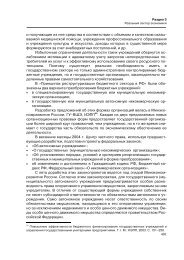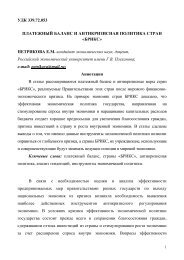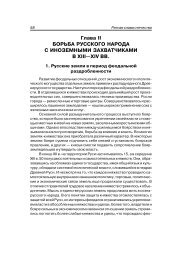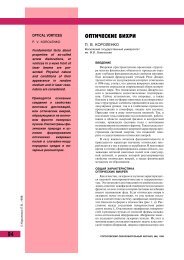Ensuring Strategic Stability in the Past and Present:
Ensuring Strategic Stability in the Past and Present:
Ensuring Strategic Stability in the Past and Present:
Create successful ePaper yourself
Turn your PDF publications into a flip-book with our unique Google optimized e-Paper software.
Similarly, it is still quite difficult to evaluate <strong>the</strong> parameters <strong>in</strong> <strong>the</strong> Ch<strong>in</strong>a-India-Pakistan trianglethat began to take shape at <strong>the</strong> end of <strong>the</strong> last decade.India set off its first peaceful nuclear explosion <strong>in</strong> 1974. After that, it set off a series of explosionsof a number of warheads that could be delivered to targets on <strong>the</strong> territory of Pakistan <strong>and</strong> Ch<strong>in</strong>a.In 1995, India’s Rao government was go<strong>in</strong>g to carry out a series of nuclear tests, but changed itsm<strong>in</strong>d under pressure from <strong>the</strong> <strong>in</strong>ternational community. 89 India’s nuclear explosions <strong>in</strong> 1998 werefilliped by Pakistan’s test<strong>in</strong>g of its Ghauri medium-range missile, which has a range of 1,500 km;this missile could hit 26 Indian large cities <strong>and</strong> <strong>the</strong> major part of nuclear facilities <strong>in</strong> India. SergeiOborotov writes that “Ghauri with a nuclear warhead evoked <strong>the</strong> long-forgotten feel<strong>in</strong>g of vulnerabilityto Pakistan among Indians.” 90 Later, Brajesh Mishra, national security advisor to India’sPrime M<strong>in</strong>ister Vajpayee, recalled: “We had to show a credible deterrent capability not only to <strong>the</strong>outside world, but to our own people.” 91In <strong>the</strong> late 1980s, India was already sure that Pakistan had nuclear weapons, <strong>and</strong> thought thatPakistan had acquired those weapons with <strong>the</strong> active assistance of Ch<strong>in</strong>a <strong>and</strong> <strong>the</strong> connivance of<strong>the</strong> United States. 92 At that time, with Rajiv G<strong>and</strong>hi’s government <strong>in</strong> power, India accelerated <strong>the</strong>implementation of its military nuclear <strong>and</strong> missile programs; at <strong>the</strong> same time, Rajiv G<strong>and</strong>hi presentedhis gradual global nuclear disarmament plan to <strong>the</strong> UN. 93Today, <strong>the</strong> only perceivable way to study <strong>the</strong> problem of secur<strong>in</strong>g strategic stability <strong>in</strong> <strong>the</strong> polygonalnuclear configurations is <strong>the</strong> consistent contemplation of <strong>the</strong> dyad relationship, with ananalysis of <strong>the</strong>ir perception by <strong>the</strong> o<strong>the</strong>r nuclear actors <strong>in</strong> <strong>the</strong> hexagon (or <strong>the</strong> heptagon). The follow<strong>in</strong>gstep is a contemplation of <strong>the</strong> relations with<strong>in</strong> <strong>the</strong> triangle with a subsequent transition to<strong>the</strong> quadrangle <strong>and</strong> to succeed<strong>in</strong>g structures.We may assume with a high degree of confidence that every time a state’s leaders, political elites<strong>and</strong> military comm<strong>and</strong>ers beg<strong>in</strong> to digest <strong>the</strong> ma<strong>in</strong> strategic stability pr<strong>in</strong>ciples related to underst<strong>and</strong><strong>in</strong>g<strong>the</strong> entirety of <strong>the</strong> consequences of <strong>the</strong> use of nuclear weapons—<strong>in</strong>clud<strong>in</strong>g <strong>the</strong> degree towhich it is possible to control military actions when <strong>the</strong> use of nuclear warheads is implied—that<strong>the</strong>y do so from <strong>the</strong> outset.The case of India <strong>and</strong> Pakistan showed that <strong>the</strong> experience of two nuclear superpowers who atsome po<strong>in</strong>t had gotten over a series of extremely dangerous crises that could have resulted <strong>in</strong> <strong>the</strong>use of nuclear weapons, was difficult to learn. (In general, most politicians are not able to learnfrom o<strong>the</strong>rs’ experiences <strong>and</strong> mistakes.)The 1999 Kargil conflict conv<strong>in</strong>c<strong>in</strong>gly proved <strong>the</strong> <strong>in</strong>consistency of <strong>the</strong> <strong>the</strong>oretical <strong>and</strong> ra<strong>the</strong>r hypo<strong>the</strong>ticalassumptions of those who believed that possession of nuclear weapons by two antagonists<strong>in</strong>creases <strong>the</strong>ir temperance <strong>in</strong> us<strong>in</strong>g military force long before <strong>the</strong>y reach nuclear threshold. Over<strong>the</strong> course of <strong>the</strong> Kargil conflict, India had to use up to ten divisions of its ground forces supportedby strike aircraft. It had to deal with about 1,000 mujahedeen who found <strong>the</strong>ir way from <strong>the</strong>territory of Pakistan to <strong>the</strong> Kargil sector <strong>in</strong> <strong>the</strong> nor<strong>the</strong>rn part of <strong>the</strong> Indian states of Jammu <strong>and</strong>Kashmir. The <strong>in</strong>vaders <strong>in</strong>cluded representatives of Pakistan’s regular armed forces. Indian troopshad to fight with Mujahedeen troops <strong>in</strong> extreme mounta<strong>in</strong> conditions, where artillery, armoredvehicles <strong>and</strong> even aviation, as a rule, did not provide any decisive advantage.46<strong>Ensur<strong>in</strong>g</strong> <strong>Strategic</strong> <strong>Stability</strong> <strong>in</strong> <strong>the</strong> <strong>Past</strong> <strong>and</strong> <strong>Present</strong>: Theoretical <strong>and</strong> Applied Questions
















